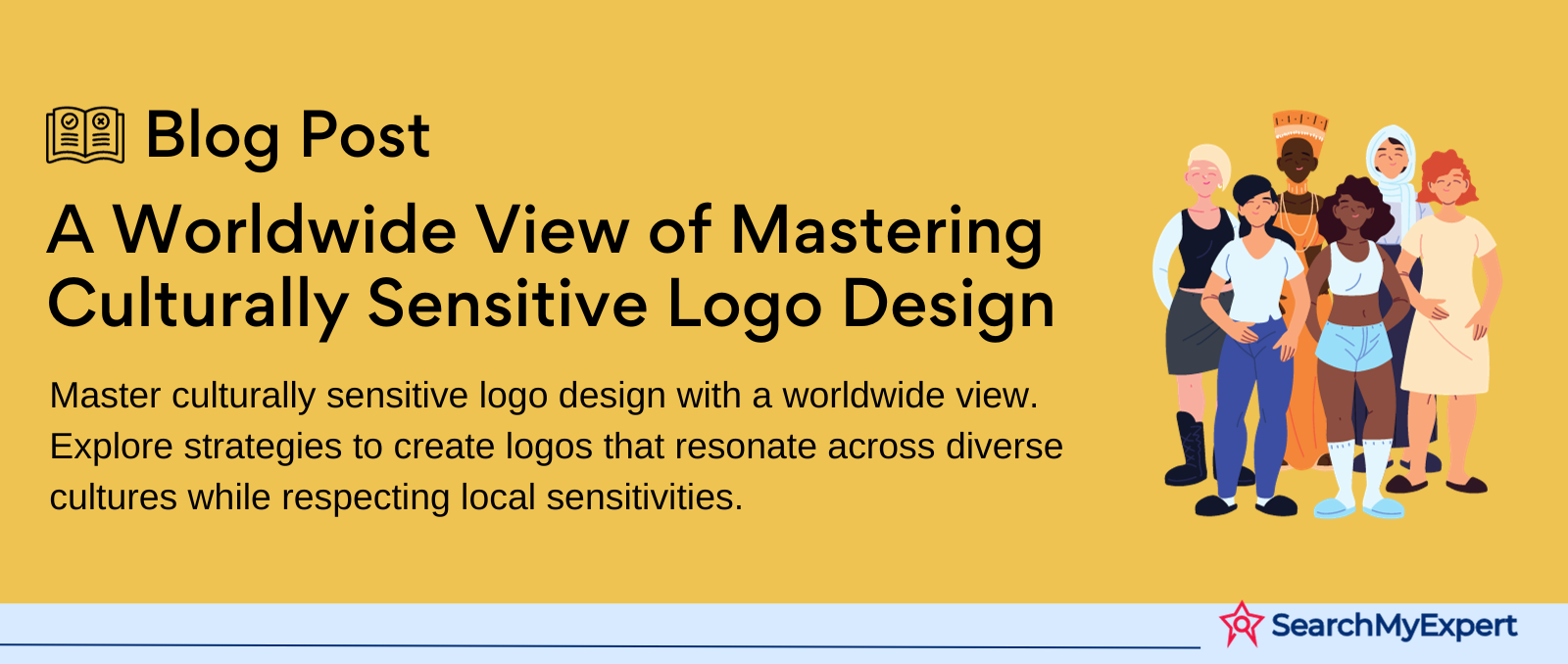A Worldwide View of Mastering Culturally Sensitive Logo Design

The Intersection of Culture and Logo Design
In the dynamic world of branding, logos stand as the silent ambassadors of a brand's identity. These visual symbols are not just artistic expressions; they are the essence of a company's brand, encapsulating its values, ethos, and identity. Logos are the first point of interaction with the audience, making them crucial for creating a lasting impression.
Diving deeper, our planet is a mosaic of diverse cultures, each with its unique set of values, beliefs, and traditions. This rich tapestry of cultures influences every aspect of our lives, including the subtleties of design. The main thrust of our discussion hinges on a pivotal idea: Cultural differences play a significant role in shaping logo design.
Why is this important? In our globally connected world, understanding the interplay between culture and logo design is not just about aesthetics; it's about effective communication. A logo that resonates well in one culture might be misunderstood or even offensive in another. Thus, recognizing and adapting to these cultural nuances is key to creating logos that truly connect with diverse audiences worldwide.
Defining Culture and its Influence on Design
Unraveling the Cultural Fabric in Design
Culture is an intricate web of elements such as language, beliefs, customs, norms, and values that define societies. When it comes to design, especially in logos, culture acts as a silent yet powerful force, shaping preferences and interpretations.
Key Elements of Culture in Design
- Colors: Colors are not just visual elements; they carry deep cultural significances. For instance, red signifies good fortune in China but can represent mourning in South Africa.
- Symbols: Cultural symbols, whether the dragon often seen in East Asian cultures or the bald eagle emblematic of the United States, can provide a deep connection to heritage and identity.
- Values: A society's core values are often reflected in its artistic expressions. A logo that embodies freedom and innovation might resonate well in a culture that values individualism, like in the USA.
Embedding Cultural Meanings in Logos
Logos can be powerful storytellers of cultural narratives. Take, for instance, the use of the lotus flower in branding within Asian cultures, symbolizing purity and enlightenment. Similarly, the incorporation of green and red in Italian logos often reflects national pride, echoing the colors of the country's flag.
Tradition and History: Pillars of Design Choices
Tradition and history are the cornerstones of cultural identity. They offer a treasure trove of design elements, from ancient patterns and scripts to historical figures and events. A logo that draws from these elements can evoke a sense of continuity and connection to the past, resonating deeply with the target audience.
Understanding and integrating these cultural nuances in logo design is not just about creating aesthetically pleasing visuals; it's about forging a deeper connection with the audience, transcending geographical and cultural boundaries.
Colors and their Cultural Significance
The Spectrum of Cultural Interpretations
Colors are not merely aesthetic choices; they are imbued with deep cultural meanings. Across the globe, the same color can evoke vastly different emotions and associations.
Diverse Cultural Meanings of Colors
- Red: In China, red symbolizes good luck and joy, while in some African cultures, it can represent mourning or death.
- White: Often associated with purity in Western cultures, white signifies mourning in many Eastern societies.
- Green: Seen as a color of prosperity and nature in many parts of the world, green can have religious connotations in Islamic cultures.
Color Choices in Logos: Harmony or Discord?
The impact of color in logo design can be profound. A green and white logo might resonate well in Ireland, reflecting the national colors, but could be perceived differently in other cultures. Similarly, a blue and white logo may appeal to Israeli audiences but carry different connotations in Argentina, where these colors are also national symbols.
Examples in Action
- McDonald's: The fast-food giant adapts its logo colors in different markets. In Europe, green is often used to reflect the continent's focus on environmental values.
- Airbnb: Their universally recognized logo uses a simple red and white color scheme, appealing broadly without significant cultural missteps.
Risks of Unintended Color Meanings
Using colors without understanding their cultural implications can lead to unintended consequences. A branding campaign with a predominantly white color scheme intended to convey purity and simplicity might be misconstrued as a symbol of mourning in some Asian countries, potentially alienating a segment of the market.
Symbols and their Cross-Cultural Interpretations
The Universal Language of Symbols
Symbols are a powerful form of communication, transcending languages and often speaking directly to the heart. However, their meanings can vary significantly across cultures, evoking a spectrum of emotions and interpretations.
Varied Meanings of Common Symbols
- Dragons: In Chinese culture, dragons are revered, symbolizing power and good fortune. In contrast, Western cultures often view dragons as malevolent creatures.
- Owls: Considered wise and noble in many Western societies, owls can be seen as harbingers of death in some Eastern cultures.
Logos and Culturally Relevant Symbols
Successful logos often incorporate symbols that resonate deeply with their target audience.
Examples of Effective Symbol Usage
- Toyota: The three overlapping ovals in Toyota's logo symbolize the unification of the heart of the customer with the heart of the product, a concept deeply rooted in Japanese values.
- Starbucks: The siren in the Starbucks logo, a mythological figure, is meant to evoke the seafaring history of coffee and the brand's Seattle roots.
Navigating Symbols with Care
The use of symbols in logos requires a delicate balance, especially when catering to a global audience.
Risks of Misinterpretation
Misunderstanding the cultural implications of symbols can lead to negative perceptions. For example, the use of a swastika, a symbol of spirituality in Hinduism and Buddhism, is highly controversial in the West due to its association with Nazism.
Typography and Language Considerations in Logo Design
The Power of Fonts and Words
Typography and language in logos go beyond mere communication; they reflect a brand's personality and cultural relevance. The choice of font and language can significantly impact how a logo is perceived across different cultural landscapes.
Impact of Font Choices
- Serif vs. Sans Serif: Serif fonts, with their decorative strokes, often convey tradition and reliability, resonating with audiences that value heritage. Sans serif fonts, known for their clean lines, suggest modernity and are favored in cultures that prioritize minimalism and innovation.
- Script Fonts: These can evoke elegance and creativity, but may not be as easily readable in every language, posing a challenge in multicultural settings.
Language Usage in Logos
The incorporation of language into logos must consider linguistic nuances and readability across cultures. For instance, a logo with Latin script might not translate well in regions where non-Latin scripts are predominant.
Designing for Multilingual Audiences
The challenge is to create a logo that is culturally and linguistically adaptable. This requires an understanding of linguistic diversity and script compatibility.
Examples of Multilingual Logo Adaptations
- Coca-Cola: The brand adapts its iconic script logo to various languages, maintaining the distinctive swirls and curves across scripts from Arabic to Cyrillic, ensuring global recognition while respecting local languages.
- Nike: The simplicity of the Nike swoosh transcends language barriers, making it universally identifiable without relying on script.
Adapting Typography for Cultural Expectations
To resonate with different cultural expectations, designers must be adept at choosing typography that reflects cultural aesthetics and values.
- Calligraphy in Eastern Cultures: In countries like China and Japan, logos incorporating calligraphic elements can convey a sense of elegance and cultural heritage.
- Bold, Simple Fonts in Western Cultures: These are often used to convey directness and clarity, aligning with a straightforward communication style.
Case Studies: Navigating Cultural Nuances in Logo Design
Successful Cross-Cultural Logo Adaptations
Airbnb
- Airbnb's Belo Symbol: A symbol of belonging, the Airbnb logo (Belo) is designed to represent people, places, love, and the 'A' of Airbnb. It's simple yet universally appealing, transcending cultural boundaries.
Starbucks
- Starbucks' Siren: The Starbucks logo, with its mythological siren, is tailored to reflect its Seattle roots and the maritime history of coffee. The logo maintains its core design globally but adapts its presentation to fit local sensibilities.
Unsuccessful Examples and Cultural Missteps
Pepsi in Southeast Asia
- Pepsi's Color Change: When Pepsi changed its vending machines' color to light blue in Southeast Asia, sales dropped. The color was associated with death and mourning in the region, illustrating a lack of cultural understanding.
Gerber in Africa
- Gerber's Baby Image: Gerber's logo with a baby's face encountered issues in African markets, where consumers are used to packaging showing the contents inside due to low literacy rates. The baby image caused confusion and discomfort.
Lessons Learned from Case Studies
- Research and Understanding: Deep cultural research and understanding are crucial. Airbnb's success lies in its universal symbolism, whereas Pepsi's oversight shows the pitfalls of not understanding color connotations.
- Adaptation and Respect: Successful global brands adapt while respecting local cultures. Starbucks keeps its core imagery but tweaks its presentation, avoiding cultural insensitivities that Gerber faced.
- Avoiding Assumptions: Never assume that a successful design in one culture will work universally. Each market needs individual consideration to avoid misinterpretations, as seen in Pepsi's and Gerber's examples.
Navigating Cultural Nuances in Logo Design
Key Takeaways
- Cultural Sensitivity: Cultural differences significantly impact logo design. Colors, symbols, typography, and language must be chosen with an awareness of their cultural connotations.
- Global vs. Local: Successful global brands balance universal appeal with local relevance. This means adapting logo elements to fit different cultural contexts without losing the brand's core identity.
- Learning from Mistakes: Case studies of both successful and unsuccessful logo designs teach us that understanding and respecting cultural nuances can make or break a brand's image in a diverse market.
Best Practices for Culturally Sensitive Logo Design
- In-depth Research: Thoroughly research cultural norms, values, and symbols of the target market. This includes understanding color meanings, symbolic representations, and language nuances.
- Engage Local Experts: Collaborate with local designers or cultural consultants. Their insights can be invaluable in identifying potential cultural pitfalls and opportunities.
- Test and Get Feedback: Before finalizing a design, test it with a diverse audience. Feedback can reveal unforeseen interpretations and help refine the logo to better suit diverse cultural perspectives.
- Adaptability: Create a flexible logo design that can be easily adapted to different cultural contexts. This might mean tweaking colors, symbols, or typography to align with local sensibilities.
- Continuous Learning and Adaptation: Stay informed about changing cultural trends and perceptions. A logo that works today may need to evolve as cultural dynamics shift.
Conclusion
Cultural research and collaboration are fundamental in the logo design process. They enable designers to create logos that not only capture the essence of a brand but also resonate deeply and respectfully with a global audience. By prioritizing cultural understanding, designers can create logos that are not just visually appealing but also culturally empathetic and globally relevant.
Let our Logo Design Company craft your business's face.
share this page if you liked it 😊
Other Related Blogs

Mastering Docker for App Development: A Comprehensive Guide to Benefits, Use-Cases, and Alternatives
STAY UP TO DATE
GET PATH'S LATEST
Receive bi-weekly updates from the SME, and get a heads up on upcoming events.
Contact Us











